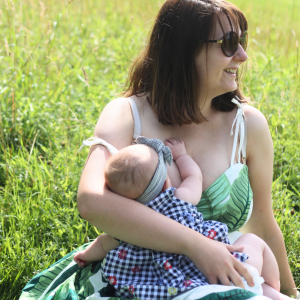





Breastfeeding can feel like a sacrifice. For the first 6 months, it might feel like it’s all you’re doing! With our calculator, we want to acknowledge just how much time, energy and love is spent on nursing your little one. Many nursing parents feel like they’re managing a silent struggle between sleep deprivation, their body changing, and a constant demand on their time and attention.
So when breastfeeding life is getting you down, or you just want to shout about how much you’ve committed to, we’ve figured out how much your time breastfeeding equates to in comparison to a few other activities! Simply fill in an approximation of how many hours per day you spend breastfeeding and for how many months you’ve done it, and the calculator will tell you the total number of hours, how much money you might have earned if that was your full time job (wow!), and a random fact that’s a little more interesting, including:
- How many times you could have watched the entire Friends boxset.
- How many full nights of sleep you could have had (we all miss those!).
- How many times you could have read all the Harry Potter books.
- How many times you could have flown around the world.
- And more!
To see another random fact, simply refresh the page and try it again!
We spoke to a few women who breastfed and combi-fed their babies, just to show how different everyone’s breastfeeding journey can be!
Sian has breastfed two babies, and admits that they were very different experiences! The estimated time she spent feeding her first was around 6480 hours over 2.5 years; her second spent more than 11,500 hours feeding over 18 months!
“It took a lot of work with my first to get the latch right, especially as I had a fast letdown! Once we got the hang of it though, she fed very efficiently so feeds would only last 10-20 minutes after a few weeks and were usually spaced out by 3 hours. I fed her until she was 2.5.
“My second had a tongue tie, so even though I felt like I should know what I was doing, I really struggled! He fed for hours at a time, as well as all night long. We made it to 18 months, but according to the calculator, the hours I spent feeding him were twice as many as my first!”

Emma explains how different factors affect their breastfeeding journey, resulting in an accumulated estimate of 4320 hours of feeding:
“At first I pretty much spent the first 3 weeks with my baby suckling for hours at a time as my milk took 10 days to come through due to low iron as I lost a lot of blood during labour and my baby also had a tongue tie which we had cut when she was 2 weeks old.
“Teething, colds, injury, missing mummy, are all factors that have increased feeding time and frequency for me. The comfort feeding at night sometimes feels like I have been breastfeeding ALL night, similarly to a lot of breastfeeding mums who are trapped comfort-feeding, I bedshare on a floor bed to make the night feeds easier so I can lie down and be half asleep whilst baby feeds for as long or little as she wants.”
Rosie detailed to us how her feeding routine changed over time as her baby got older:
“When she was 2 months old she fed for around 3 hours a day, split up into feeds that lasted anywhere from 10-30 minutes. There are a few 40 min feeds in there too but mostly around the 20 minute mark.
“By 6 months she fed for around an hour a day, feeds were anywhere from 5-15 mins but usually falling around the 10 minute mark.”
To help you understand the results the calculator is giving you and to alleviate any worries, we’ve answered a few frequently asked questions about breastfeeding below.
How often should my baby breastfeed?
The first and most important thing to stress is that every breastfeeding journey is different, and not just between parents either; siblings can feed very differently. So if your friend only feeds their baby 6 times a day for 10 minutes at a time, but you’re feeding 12 times a day for 45 minutes each time, this isn’t something to be concerned about, unless there are other factors such as your baby not gaining weight steadily.
The first few days (and even weeks) of breastfeeding do not dictate your entire journey. The first milk your baby receives while breastfeeding is called colostrum which is a thick golden yellow substance. It’s highly concentrated so newborns do not need much of it.
In the next 2-4 days, you notice your breasts become fuller as your milk “comes in”. You can help this to progress and to build up your milk supply by keeping your little one close to you with plenty of skin to skin contact. This will also not only help your bond with your baby, but will also help them to develop their latching on reflexes. At this stage, it’s recommended to feed your baby as often as they want for as long as they want. The very rough guide provided by the NHS is at least 8 to 12 times or more, throughout day and night, every 24 hours during the first few weeks.
If your baby is particularly sleepy or not engaging in full feeds often enough, especially in the early days, you may need to wake them to feed. A midwife may provide you with a feeding plan with more frequent feeding intervals if required.
Feeding as often as they need it is not spoiling your baby. You cannot overfeed a breast baby as your body adapts your milk supply to your baby’s needs.
After the first few weeks, you’ll find that your baby’s feeds will likely become slightly shorter with bigger intervals in between. You can expect gaps of up to 3 hours between feeds and maybe more during the night. But if this is not the case, it does not necessarily mean anything is wrong. Some babies just require more comfort and feed a lot more frequently even as they grow.
What should a full breastfeed look like?
A breastfeed begins when your baby shows cues of wanting to feed, which may include smacking lips, rooting, sucking on their fists, or simply becoming more alert when they’re younger.
Getting a good latch is the next step, and it’s absolutely crucial. Your baby needs to open their mouth wide, tilt their head slightly backwards and take a good mouthful of the areola into their mouth as well as the nipple. Not achieving a good latch can result in problems such as your little one not being able to extract the milk effectively, resulting in a hungry or gassy baby and potential milk supply issues for mum. Some signs of a poor latch that you may notice are a misshapen nipple after baby comes off the breast, soreness during and after feeding, clicking noises and baby’s cheeks sucking in as they feed, lips tucked under instead of flared outwards, and weight loss.
It’s important to work on your baby’s latch together. If you are struggling (as so many mums do!), speak to your midwife in the early days or health visitor when you’re discharged from midwife care. Most areas have a breastfeeding group with trained peer supporters who can help you to get a better latch. Your hospital trust may have a specialist who can help you, or there are also private qualified breastfeeding specialists. It may be that your baby is struggling due to a factor such as tongue tie which can be assessed and fixed by a specialist if required. Whatever you do, do not suffer in silence as help is available and the vast majority of parents need it, even if they’ve already fed one or more babies!
If the latch feels uncomfortable or doesn’t look right, the best thing to do is to remove baby and relatch. You can do this by popping a clean finger into the side of their mouth to break the suction, then repositioning and trying again. In the early days, this may take several attempts, but try not to feel overwhelmed by it.
Once they are latched, baby will begin to suckle to stimulate your let down. There are a couple of ways to know that they have initiated it: if baby pulls off, you may see milk spraying out (particularly if you have a fast let down); or you may feel a tingling feeling as it begins. Some women do not experience this, so keep an eye on your baby’s sucking. Once the milk is flowing, you will notice that their suckling may slow slightly and you will begin to hear swallows. Your little one should suckle in a somewhat rhythmic pattern, although for some this may be stronger and slower, others may be quicker.
You may find that after some time, your baby pauses in their rhythm then suckles quickly in a rapid shallow way. This is called flutter sucking and they may not be actively feeding at this point but sucking for comfort or to try to initiate a second letdown. They may fall asleep after this or they may recommence feeding as before.
When your baby has finished feeding, they may release the breast or they may continue flutter sucking and you can remove them yourself with gentle encouragement if you feel confident enough that they have effectively removed the milk. Your breast tissue may feel softer and less full, and baby will have stopped swallowing.
Depending on your baby, you may want to switch sides to the other breast. Many stop for a burp break in between sides to help baby feel more comfortable.
How do I know if my baby is getting enough milk?
This is a question that worries a lot of breastfeeding parents. When feeding with a bottle, you can see exactly how much your baby is taking in at each feed and how often, but breastfeeding feels like you’re in the dark!
The best way to know is their weight gain. They should be steadily following their centile lines with regular weigh-ins. If you’re between weigh-ins, one thing to pay attention to is whether they’re growing into or out of their clothes. You can always request another weigh-in from your health visitor or doctors surgery if you’re feeling concerned. Some areas also have drop-in clinics or self-weigh locations.
If you are worried that your baby isn’t getting enough milk, whether that’s because they’re not gaining weight, the feeds are very short when they’re young, they’re bringing back up excessive amounts of milk, or anything else, the best course of action is to speak to your health visitor who will be able to advise you on your best course of action. They may direct you to a breastfeeding specialist or group who can watch your baby feeding and give you pointers on how to help your little one feed more effectively. They may also refer you to a doctor if they feel that there is something medical that needs to be looked at such as reflux or a tongue tie. The main thing is not to worry about seeking advice at any stage of your breastfeeding journey as there are plenty of people who are very willing to help!
What is lazy breastfeeding?
In the middle of the night, when we’re fighting to stay awake for yet another hour but baby is dozing at the breast, we’ve all wondered: “How long have I spent breastfeeding my baby?” as well as “Is this baby even still feeding?!”
It’s important to remember that our little ones are not always just feeding to fill up their tiny tummies. Breast milk also contains a vast array of antibodies to support their immune system, which is why you may find them feeding more if they’re feeling unwell, or it might even become a signal to you that they’re coming down with something! There are also hormones in breast milk that help with their development and regulate metabolism. Many also breastfeed simply for comfort, as it strengthens the emotional bond between mum and baby. And luckily for you, breastfeeding is also beneficial for the feeding parent who will have a lowered risk of diseases like breast and ovarian cancer and osteoporosis among others.
So if your little one is falling asleep at the breast, it may be that they needed that comfort to help them feel safe enough to do so (remember that fourth trimester!). As long as they are getting a full feed before falling asleep, this isn’t a problem. You can make sure of this in a couple of ways: your baby is continuing to gain weight steadily and following their centile lines; and keeping an eye that their feeds are as described above.
If you are worried that they are falling asleep too early into the feed and are not finishing a full feed, you may need to rouse your baby to continue feeding. This can be done by gently stroking their face, removing their socks and giving their feet a tickle, removing an item of clothing or changing their nappy. Some babies are a little more stubborn than others and may need more encouragement, but it is important to get a full feed!
Is a 10 minute feed long enough for a baby?
As your baby grows, their feeding routines will change. For a newborn, 10 minutes is likely not enough for them to get a full feed every time, but once they’re more than a few months old, if they have settled into a routine of 10 minute feeds and are continuing to gain weight steadily, this is fine.
You can expect a full feed to take between 15 and 60 minutes, but you shouldn’t set a time limit and watch baby’s cues rather than trying to get them onto a schedule. Responsive feeding is the best way for you and your baby to build a strong breastfeeding relationship.



